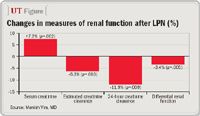Article
LPN shows small, significant effect on renal function
Author(s):
Atlanta-Laparoscopic partial nephrectomy (LPN) for solitary and multiple renal tumors led to a small but statistically significant decrease in postoperative renal function, but the clinical significance of the finding remains unclear, according to a retrospective review of a patient series at the National Cancer Institute, Bethesda, MD.

Following surgery, serum creatinine increased, and estimated creatinine clearance, 24-hour urine creatinine clearance, and differential renal function all decreased. Examination of potential factors associated with the changes revealed few clues, said Manish Vira, MD, a clinical fellow working with Peter A. Pinto, MD, at the Urologic Oncology Branch of the NCI.

The patients' mean age was 50.9 years, and 28 of the 50 were men. Dr. Vira reported that 28 patients underwent LPN without arterial clamping and 22 with clamping, with an average warm ischemic time of 28.2 minutes. Mean tumor size ranged between 2.35 and 2.75 cm in both groups, estimated blood loss averaged 393 cc, and operative time averaged 310 minutes.
Significant differences in renal values
Only one of 36 evaluable patients had positive surgical margins. Seven patients had surgical complications that included urine leakage (five), pulmonary embolism (one), and perinephric hemorrhage (one). No patient required temporary or long-term dialysis after surgery.
Analysis by Wilcoxon signed rank test revealed statistically significant differences between preoperative and postoperative values for measures of renal function assessed in the study. Serum creatinine increased by 7.2%, and estimated creatinine clearance decreased by 6.3%, 24-hour urine creatinine clearance by 11.9%, and differential renal function, by 3.4%.
Investigators analyzed associations between a dozen different demographic, clinical, and operative variables and change in renal function and found few predictive factors. Operative time showed a weak correlation with an increase in postoperative serum creatinine and a decrease in postoperative estimated creatinine clearance, but surgical approach, use of arterial occlusion, and clamp time did not show a significant effect on postoperative renal function.
Analysis of the relationship between changes in serum creatinine and 24-hour urine creatinine clearance revealed no evidence of a statistically significant relationship, a finding that highlights the need to develop a more accurate and consistent measurement of renal function.
"This is one more study in a wealth of studies showing this procedure [LPN] is safe and doesn't have a drastic impact on renal function," Dr. Vira said. "We had a subset of patients who underwent hilar clamping with warm ischemia, and that did not seem to have much of an impact on postoperative renal dysfunction."
Dr. Pinto and colleagues at the NCI are currently investigating new biomarkers of renal function to aid research in LPN.
Newsletter
Stay current with the latest urology news and practice-changing insights — sign up now for the essential updates every urologist needs.
















